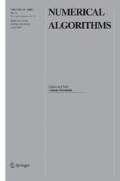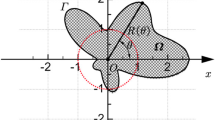Abstract
We present a multidomain spectral approach for Fuchsian ordinary differential equations in the particular case of the hypergeometric equation. Our hybrid approach uses Frobenius’ method and Moebius transformations in the vicinity of each of the singular points of the hypergeometric equation, which leads to a natural decomposition of the real axis into domains. In each domain, solutions to the hypergeometric equation are constructed via the well-conditioned ultraspherical spectral method. The solutions are matched at the domain boundaries to lead to a solution which is analytic on the whole compactified real line \(\mathbb {R}\cup {\infty }\), except for the singular points and cuts of the Riemann surface on which the solution is defined. The solution is further extended to the whole Riemann sphere by using the same approach for ellipses enclosing the singularities. The hypergeometric equation is solved on the ellipses with the boundary data from the real axis. This solution is continued as a harmonic function to the interior of the disk by solving the Laplace equation in polar coordinates with an optimal complexity Fourier–ultraspherical spectral method. In cases where logarithms appear in the solution, a hybrid approach involving an analytical treatment of the logarithmic terms is applied. We show for several examples that machine precision can be reached for a wide class of parameters, but also discuss almost degenerate cases where this is not possible.












Similar content being viewed by others
Notes
The Kummer group of symmetries of the hypergeometric equation is essentially generated by Moebius transformations which leave the set of singularities 0, 1, ∞ invariant; note that such a symmetry does not exist for Fuchsian equations with four singularities, but our approach can still be applied as discussed in Section 6.
In Fig. 5, the results for the Fourier spectral method are plotted against N and not n, as the axis label indicates.
The next section gives an example where the condition numbers of the system (12) become large. For the example considered in Fig. 11, for 𝜖 = 10− 1, 10− 5, 10− 10, the condition numbers of the system (18)–(19) are on the order of 104, 108 and 1013, respectively, and those of (20)–(21) are on the order of 106, 1014 and 1024, respectively.
References
Abramowitz, M., Stegun, I. (eds.): Handbook of Mathematical Functions with Formulas, Graphs, and Mathematical Tables. National Bureau of Standards (1970)
Atkinson, K., Han, W.: On the numerical solution of some semilinear elliptic problems. Electron Trans. Numer. Anal. 17, 206–217 (2004)
Auzinger, W., Karner, E., Koch, O., Weinmüller, E.B.: Collocation methods for the solution of eigenvalue problems for singular ordinary differential equations. Opuscula Math. 26, 29–41 (2006)
Berrut, J.-P., Trefethen, L.N.: Barycentric Lagrange interpolation. SIAM Rev. 46(3), 501–517 (2004)
Boyd, J.P., Yu, F.: Comparing seven spectral methods for interpolation and for solving the Poisson equation in a disk: Zernike polynomials, Logan–Shepp ridge polynomials, Chebyshev–Fourier series, cylindrical Robert functions, Bessel–Fourier expansions, square-to-disk conformal mapping and radial basis functions. J. Comput. Phys. 230(4), 1408–1438 (2011)
Clarkson, P.A.: Painlevé Equations – Nonlinear Special Functions, Lecture Notes in Mathematics, p 1883. Springer, Berlin (2006)
Driscoll, T.A., Hale, N., Trefethen, L.N. (eds.): Chebfun Guide. Pafnuty Publications, Oxford (2014)
Dubrovin, B., Grava, T., Klein, C.: On universality of critical behaviour in the focusing nonlinear Schrödinger equation, elliptic umbilic catastrophe and the tritronquée solution to the Painlevé-I equation. J. Nonl. Sci. 19(1), 57–94 (2009)
Fiziev, P.P., Staicova, D.R.: Solving systems of transcendental equations involving the Heun functions. Am. J. Comput. Math. 2, 2 (2012)
Fornberg, B., Weideman, J.A.C.: A numerical methodology for the Painlevé equations. J. Comp. Phys. 230, 5957–5973 (2011)
Frauendiener, J., Klein, C.: Computational approach to hyperelliptic Riemann surfaces. Lett. Math. Phys. 105(3), 379–400 (2015). https://doi.org/10.1007/s11005-015-0743-4
Frauendiener, J., Klein, C. In: A. Bobenko, C. Klein (eds.) Computational Approach to Riemann Surfaces, Lecture Notes in Mathematics, vol. 2013. Springer (2011)
Frauendiener, J., Klein, C.: Computational approach to compact Riemann surfaces. Nonlinearity 30(1), 138–172 (2017)
Klein, C., Stoilov, N.: Numerical approach to Painlevé transcendents on unbounded domains. SIGMA 14, 68–78 (2018)
Mason, J.C., Hanscomb, D.C.: Chebyshev Polynomials. Chapman and Hall/CRC (2002)
Olver, F W.J., Olde Daalhuis, A.B., Lozier, D.W., Schneider, B.I., Boisvert, R.F., Clark, C.W., Miller, B.R., Saunders, B.V.: NIST digital library of mathematical functions, https://dlmf.nist.gov, Release 1.0.22 of 2019-03-15
Olver, S., Townsend, A.: A fast and well-conditioned spectral method. SIAM Rev. 55(3), 462–489 (2013)
Pearson, J.W., Olver, S., Porter, M.A.: Numerical methods for the computation of the confluent and Gauss hypergeometric functions. Numer Algor. 74, 821–866 (2017)
Seaborn, J.B.: Hypergeometric Functions and their Applications. Springer (1991)
Trefethen, L.N., Weideman, J.A.C.: Two results on polynomial interpolation in equally spaced points. J. Approx. Theory 65(3), 247–260 (1991)
Trefethen, L.N.: Spectral Methods in Matlab. SIAM, Philadelphia (2000)
Trefethen, L.N.: Approximation Theory and Approximation Practice, vol. 128. SIAM (2013)
Wilber, H.D.: Numerical Computing with Functions on the Sphere and Disk. Boise State University, Master’s thesis (2016)
Wilber, H.D., Townsend, A., Wright, G.B.: Computing with functions in spherical and polar geometries II. The disk. SIAM J. Sci. Comput. 39(3), C238–C262 (2017)
Weideman, J.A.C., Reddy, S.C.: A Matlab differentiation matrix suite. ACM TOMS 26, 465–519 (2000)
Acknowledgements
We thank C. Lubich for helpful remarks.
Funding
This work was partially supported by the PARI and FEDER programs in 2016 and 2017, by the ANR-FWF project ANuI by the isite BFC via the project NAANoD and by the Marie-Curie RISE network IPaDEGAN. M. Fasondini acknowledges financial support from the EPSRC grant EP/P026532/1.
Author information
Authors and Affiliations
Corresponding author
Additional information
Publisher’s note
Springer Nature remains neutral with regard to jurisdictional claims in published maps and institutional affiliations.
Rights and permissions
About this article
Cite this article
Crespo, S., Fasondini, M., Klein, C. et al. Multidomain spectral method for the Gauss hypergeometric function. Numer Algor 84, 1–35 (2020). https://doi.org/10.1007/s11075-019-00741-7
Received:
Accepted:
Published:
Issue Date:
DOI: https://doi.org/10.1007/s11075-019-00741-7




